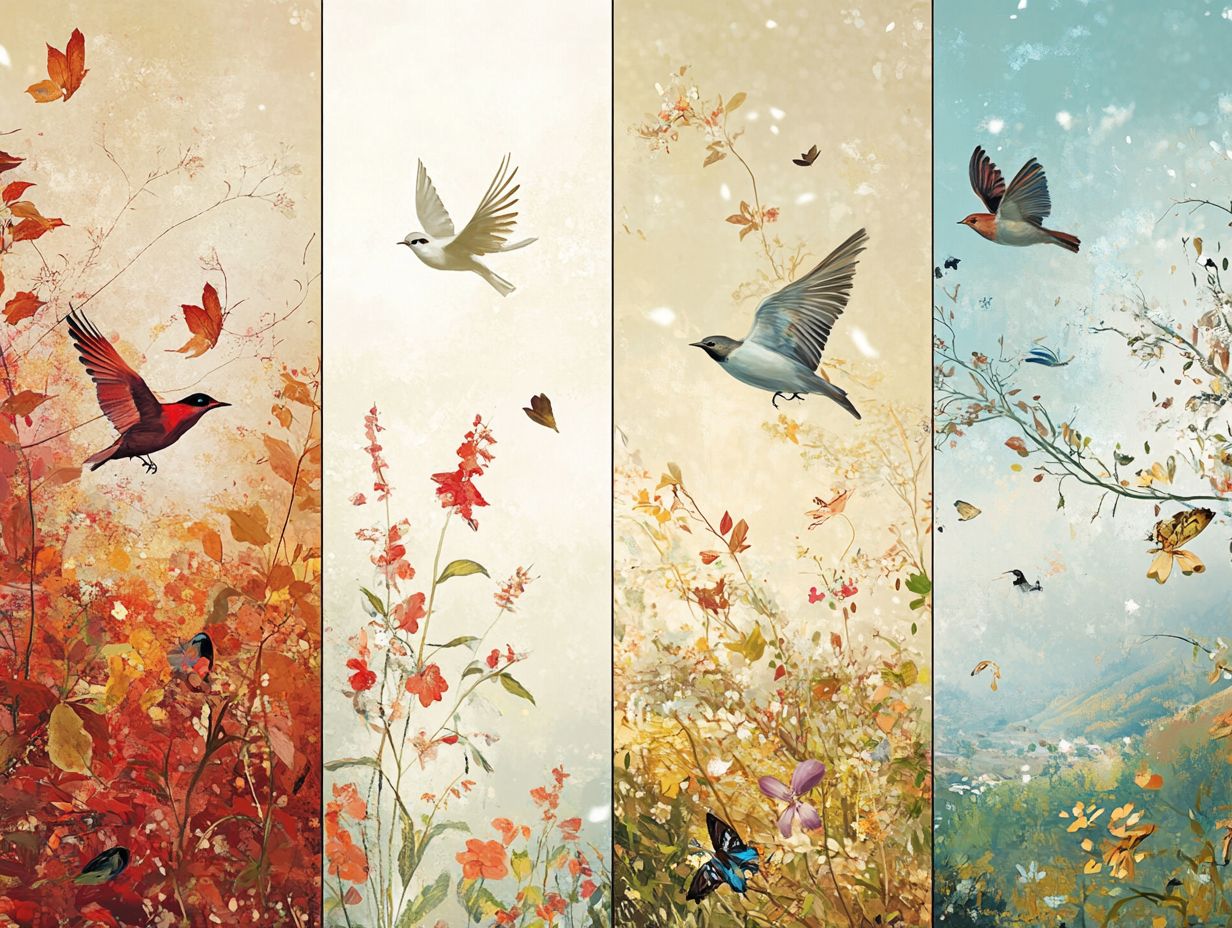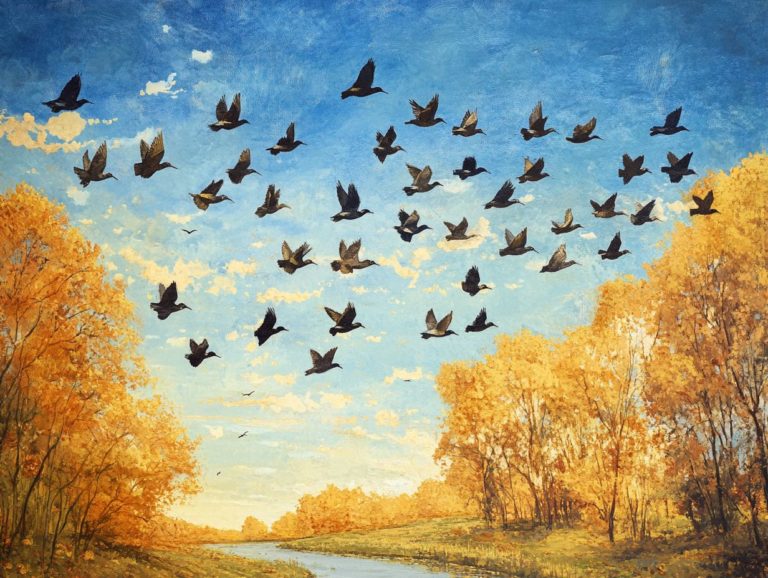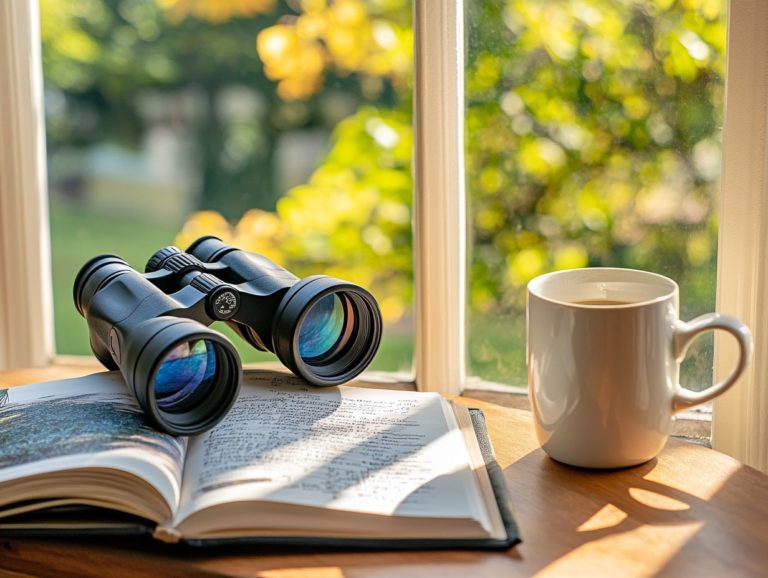How to Spot Birds During Different Seasons?
Bird watching is a delightful hobby that immerses you in nature, letting you appreciate the stunning beauty and diversity of avian life.
Whether you re a seasoned bird watcher or just dipping your toes into this engaging hobby, grasping the optimal seasons for spotting various species can truly enrich your experience.
Get ready to discover the peak times to observe birds, showcase common species you might encounter in each season, and equip you with essential tools and techniques to elevate your bird-watching skills.
Join us on this adventure and unlock the joys of birdwatching!
Contents
- Key Takeaways:
- Best Seasons for Bird Watching
- Identifying Birds by Season
- Tools and Techniques for Spotting Birds
- Frequently Asked Questions
- What are the best tips for spotting birds in every season?
- How can I identify different types of birds during different seasons?
- What are some common birds to look out for during spring?
- How can I spot birds during the winter months?
- What should I bring with me when bird watching during different seasons?
Key Takeaways:

- Always check the best seasons for bird watching in your area. Different birds appear in different seasons.
- Learn how to identify birds by season. Keep an eye out for common species in spring, summer, fall, and winter.
- Use tools like binoculars and field guides. Techniques like patience and careful observation will enhance your birdwatching experience.
What is Bird Watching?
Bird watching, or birdwatching, is a captivating recreational activity where you observe and identify various bird species in their natural habitats. This hobby provides you with invaluable insights into bird behavior, migration patterns, and seasonal changes.
Not only does it bring you joy, but it also fosters environmental conservation by deepening your appreciation for wildlife. You might find yourself utilizing field guides and apps like Merlin to enhance your understanding of different feather colors (the feathers covering a bird) and seasonal migrations, all of which contribute to a greater awareness of the ecological balance.
As you immerse yourself in this activity, you engage in the delightful challenge of identifying diverse species, each boasting unique characteristics and behaviors. This process cultivates a personal connection with nature, making you more inclined to support conservation efforts that protect vital habitats threatened by human activities.
By tracking migration patterns throughout the seasons, you gain insights into the environmental shifts impacting bird populations, which can inspire awareness and action toward habitat preservation. The joy and fulfillment you experience while bird watching enrich your life and play a crucial role in fostering a sense of responsibility for preserving our planet’s rich biodiversity.
Best Seasons for Bird Watching
Birdwatching becomes exceptionally rewarding during certain seasons when various bird species reveal remarkable changes in behavior, feather colors, and migration patterns. To enhance your experience, learning how to spot birds in urban areas is essential for observing these avian wonders at their best.
Each season offers its own distinct opportunities from the early migration of waterfowl and shorebirds in spring to the vibrant displays of songbirds in summer.
You can enjoy birdwatching right in your backyard, observing local species and their habits, or venture into state parks, experiencing the thrill of the chase as you capture fleeting glimpses of your feathered counterparts.
When and Where to Look for Birds
The best time to spot birds is at dawn. The morning hours offer a peaceful setting filled with the sounds of nature. These moments create perfect conditions for spotting various species, especially in tranquil settings like state parks or near migration rivers.
For birdwatchers like yourself who want to elevate the experience, visiting popular spots such as migration rivers or well-kept trails in state parks can prove extremely rewarding. These locations typically attract larger numbers of birds, particularly during migration seasons.
It s wise to check the weather forecasts; calm, clear days are your best bet, as windy or rainy conditions can obscure visibility and lessen bird activity. Planning your excursions on weekdays may offer a more peaceful experience, as many natural sites are less crowded, allowing for focused birdwatching.
Being mindful of the seasons can also enhance your results, as certain species are more active during their breeding or feeding periods.
Identifying Birds by Season

Identifying birds by season requires a good understanding of the unique characteristics that appear at different times of the year. This includes noting specific changes in feather color and pattern, how birds move to different places during seasons, and learning how to spot birds from a distance as the adaptations that bird species undergo while transitioning between their breeding and nonbreeding ranges.
Observing these seasonal shifts is crucial for enthusiasts like you. It sharpens your ability to recognize birds by their appearance, song patterns, and behaviors across spring, summer, fall, and winter. To enhance your experience, check out what birds you can expect to see this season.
Common Birds to Spot in Spring
Spring presents a stunning opportunity for birdwatching. A host of songbirds return from their winter migrations, filling the air with their enchanting melodies while diving into their breeding season activities.
You can spot various species, such as the Common Loon and American Goldfinch, as they establish territories and prepare for nesting. This lively season offers you exceptional chances to observe and identify these beautiful birds.
As countless migratory birds arrive, each one adds its unique song and behavior, creating a symphony of sounds in local habitats. The melodic phrases of the Warbling Vireo often echo through the budding trees.
The striking yellow plumage of the American Goldfinch stands out against the vibrant landscape. These birds also play important roles in pollination and seed dispersal within their ecosystems.
By understanding migration patterns and their significance, you deepen your appreciation for the intricate relationship between these avian visitors and their environments. Understanding this helps you connect with nature in a deeper, more enjoyable way during this enchanting season.
Summer Birds to Look Out For
Summer is the pinnacle of birdwatching for you. Countless species are in their breeding ranges and flaunt their stunning plumage changes, making them a delight to spot and identify.
During this vibrant season, you’ll love diving into the lively activities of songbirds, raptors, and waterfowl as they nurture their young and engage in territorial displays, infusing your birdwatching experience with excitement.
These birds not only dazzle with captivating colors but also offer a unique tapestry of vocalizations and social interactions. For example, in the early morning hours, the distinctive calls of warblers create a symphony that entices you to listen intently.
As the sun dips below the horizon, the varied characters of chirps and whistles become more pronounced, revealing the intricate breeding rituals and social hierarchies among species. By tuning into these details, you’re not just watching birds; you’re uncovering the secrets of nature.
Fall and Winter Bird Species
As fall approaches, you re presented with the enchanting spectacle of migration. Many bird species gather in large flocks, heading south to their nonbreeding ranges, offering you thrilling opportunities for identification.
Observing the behaviors of wintering waterfowl and raptors is particularly rewarding during this time. You ll notice how they adapt to the chill, shifting their feeding strategies and providing fascinating insights into avian behavior.
During this season, honing in on the subtle differences in plumage and vocalizations can elevate your birdwatching experience. Winter often ushers in captivating species like snowy owls and trumpeter swans, each with their striking appearances and intriguing habits that will surely delight any enthusiast.
Equipping yourself with binoculars and field guides can significantly enhance your ability to recognize various birds. Pay attention to changes in feeding patterns like increased foraging around open water or fields as these can reveal valuable insights about local populations.
By embracing these seasonal shifts, every outing transforms into an opportunity to witness nature’s breathtaking adaptations. Grab your binoculars and get ready for an adventure in birdwatching!
Tools and Techniques for Spotting Birds

To elevate your birdwatching experience, harness a range of tools and techniques for spotting and identifying bird species. Binoculars and field guides are critical in enhancing your ability to observe these creatures in their natural habitats.
Embrace modern technology to enrich your birdwatching. The Merlin app is an invaluable resource that helps you recognize different species and gain insights into their behaviors, migration patterns, and plumage variations all in real time.
Binoculars, Field Guides, and Other Tools
Binoculars are essential for any birdwatcher, offering the visual clarity needed to spot birds from afar without disrupting their natural behaviors. When paired with field guides, these tools create a holistic approach to identifying various bird species, their plumage, and unique traits.
With many types of binoculars available, understanding your options can elevate your experience. For instance, waterproof and fog-proof models are great for coastal or humid regions, while lightweight versions are perfect for navigating dense forests.
Field guides come in various formats, from compact books with vivid photographs to digital apps featuring audio calls and interactive maps. Consider factors like magnification (how much closer you can see), field of view, and overall weight for comfort during your excursions.
By using these resources, you can dive into nature and let the wonders of birdwatching captivate you while fostering a respect for wildlife.
Tips for Finding and Observing Birds
Finding and observing birds effectively requires understanding their habits and having a sharp eye for detail. Early morning is the prime time for spotting various species in a tranquil setting. Grasping bird behavior and employing suitable techniques can enhance your birdwatching experience.
Planning excursions to local parks, nature reserves, or wetlands boosts your chances of fruitful sightings, as these locations are hotspots for diverse bird populations. Utilizing binoculars and adopting an unobtrusive approach will let you catch a closer glimpse into the captivating lives of these creatures. Observing their flight patterns, social interactions, and feeding habits offers insights into their roles within the ecosystem.
As you immerse yourself in these moments, documenting your experiences with notes or photographs deepens your appreciation for nature and inspires you to share your stories with fellow birdwatchers.
Frequently Asked Questions
What are the best tips for spotting birds in every season?

- Familiarize yourself with local birds: Knowing which birds are present during different seasons makes it easier to spot them.
- Watch for habitat changes: Season changes alter bird habitats. Look for new vegetation that attracts different birds.
- Identify food sources: Birds are often drawn to areas with abundant food. Keep an eye out for fruits, seeds, and insects that vary by season.
- Learn bird calls: Knowing the calls of different birds helps you locate them, as they are often more vocal during certain seasons.
- Observe behaviors: Different seasons bring different bird behaviors, such as migration or mating rituals. Knowing what to look for increases your spotting chances.
- Keep a birding journal: Recording your observations can help you track which birds are present in different seasons for future outings.
How can I identify different types of birds during different seasons?
1. Take note of physical characteristics. Look at the size, shape, and color of the bird. These features can reveal its type.
2. Observe markings and patterns. Different birds have unique feather markings, which can help with identification.
3. Use a field guide or birding app. These resources offer detailed information and images of various bird species, making identification easier.
4. Consider habitat and behavior. Birds often indicate their type through their surroundings. For example, a bird near water is likely a water bird.
5. Don’t hesitate to ask for help! Fellow birdwatchers or online forums can provide useful tips for identifying birds.
What are some common birds to look out for during spring?
1. Spring brings a thrilling chance to see birds that travel long distances as they return from their winter homes!
2. Songbirds return to their breeding grounds, filling the air with their melodic calls.
3. Waterfowl, like ducks and geese, can be found in abundance as they seek mates and nesting sites.
4. Birds of prey, such as hawks and falcons, become active as they hunt for food for their young.
5. Woodpeckers also become more active during spring while searching for insects to feed their growing chicks.
How can I spot birds during the winter months?
1. Look for wintering birds. Many species migrate during the winter, so watch for those not typically seen in other seasons. For more insights on timing, check out when is the best season for bird watching.
2. Keep bird feeders stocked. Providing a food source attracts a variety of birds to your yard even in winter.
3. Check for water sources. Birds need water for drinking and bathing, so ensure your bird bath is filled.
4. Search for wintering habitats. Some birds seek shelter in dense shrubs or evergreen trees during the cold months.
5. Be patient! Bird activity may be lower in winter, so it might take time to spot them. Keep observing your surroundings.
What should I bring with me when bird watching during different seasons?
1. Binoculars are essential for spotting and identifying birds from a distance.
2. A field guide or birding app is helpful to identify birds and learn about their habitat and behavior.
3. Bring a camera to capture photos of birds for identification or to look back on later.
4. Don’t forget water and snacks! Staying hydrated and energized is important for longer outings.
5. Dress appropriately for the weather and wear comfortable shoes for walking in various terrains.
6. Keep note-taking materials handy. A journal or notepad is useful for recording your observations and sightings.





